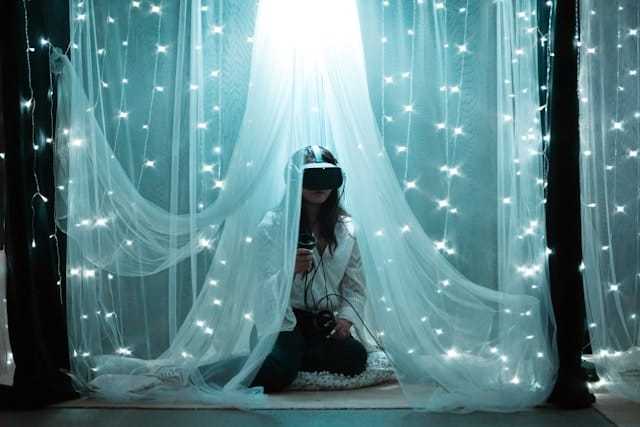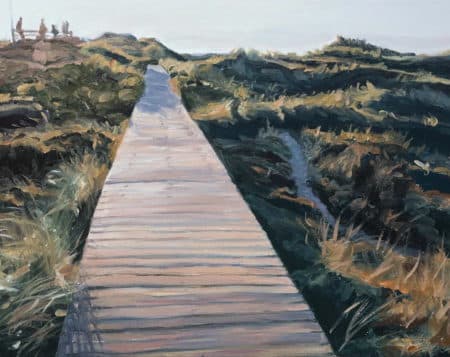Virtual galleries and museums not only become an addition to traditional exhibitions, but also to an independent and significant part of the cultural landscape, which is a synthesis of technology and artistic expression.
Innovative applications from VR in art
One of the main advantages of VR galleries is the possibility of creating unique exhibitions that would be impossible to realize in a physical space. Unreal Garden project, for example, offers users immersive, interactive art spaces in which works of art interact in real time with the physical environment.
In these rooms, viewers can observe how digital objects change and react to their actions, which enables a deeper examination of art .
Museum of Other Realities project also illustrates the potential of VR to create unique art spaces. It is a virtual museum with works by digital artists and installations that have been created especially for the virtual environment.
Here, complex, dynamic installations can be explored that could not be feasible in conventional museums, and it becomes clear how the possibilities of artistic expression expand. Specialized software plays an important role in creating such rooms, because it enables the integration of different elements of the virtual environment and interaction with the user.
Technological trends and challenges
Today's VR galleries use advanced technologies such as 5G and cloud computing to offer a smooth and high-quality experience. 5G enables data transmission with minimal latency, which is crucial for maintaining interactivity in real time. Cloud solutions in turn enable the scalability and availability of virtualized rooms without having to save large amounts of data locally.
However, the developers also present the existing technologies in front of a number of challenges. For example, the high costs for the hardware, which is necessary to create and access VR galleries, limit the accessibility for a wide audience.
In addition, the creation of high -quality content requires considerable effort and financial investments, which can be problematic independent artists and small galleries
Accessibility and integration
Virtual galleries have the potential to significantly improve the accessibility of art. Platforms such as Google Arts & Culture are already taking steps in this direction by offering virtual tours through the world museums and exhibitions. In this way, viewers from all over the world can people with disabilities , works of art and cultural sights that have so far been inaccessible to them.
In addition, VR galleries can help create integrative and diverse cultural areas by presenting works by artists from different cultures and social groups that are underrepresented in traditional museums. The application of VR technologies can diversify the representation of cultural contexts and offer the viewer a rich and complex experience.
Study shows positive effects of virtual art galleries on our well -being
A large number of research results indicate that dealing with visual arts and visiting art museums have positive effects on personal well -being; However, less is known about the possible advantages of digital forms of participation.
Recent literature provides initial indications of the advantages of digital art engagement, but further studies on the mechanisms and potential influencing factors of the advantages are necessary.
A scientific study by researchers at the University of Pennsylvania now looked at the effects of repeated visits in a virtual art gallery and aimed to clarify three central questions:
- Are there any differences in well -being, in the emotions and in immersion between people who visit a digital art gallery and those who read about art?
- To what extent influence the quality of the visit of a virtual art gallery (i.e. emotion and immersion)?
- Can the visiting qualities and personal differences be drawn about well -being?
A sample of 890 adults from the USA was recruited. The results indicate that:
- People in a virtual gallery show a higher well -being, more intensive immersion and show stronger aesthetic emotions than those who read about art
- The openness to experience is strongly related to the quality of the visit
- Diving (immersion), positive and aesthetic emotions, extra version and neuroticism correlate with well -being.

photo by Sophia sideri @sophisid, via unsplash
This study suggests that repeated disputes with art in digital format are advantageous and that future research should continue to examine the underlying mechanisms and the optimal design options of digital art experiences as effective interventions for well -being.
Future prospects
The future of the VR galleries is linked to further technological developments and conceptual innovations. In the coming years, the emergence of new formats and methods of interaction with art, such as augmented reality (AR) and Mixed Reality (MR) , can combine the elements of the virtual and real world.
This will create new opportunities for hybrid exhibitions in which physical and digital elements are integrated to enable unique and diverse artistic experiences.

Owner and Managing Director of Kunstplaza. Publicist, editor, and passionate blogger in the field of art, design, and creativity since 2011. Successful completion of a degree in web design as part of a university program (2008). Further development of creativity techniques through courses in free drawing, expressive painting, and theater/acting. Profound knowledge of the art market through many years of journalistic research and numerous collaborations with actors/institutions from art and culture.


















